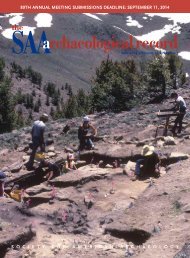SAA
SAA_Record_Nov2015
SAA_Record_Nov2015
Create successful ePaper yourself
Turn your PDF publications into a flip-book with our unique Google optimized e-Paper software.
The Magazine of the Society for<br />
American Archaeology<br />
Volume 15, No. 5<br />
November 2015<br />
The <strong>SAA</strong> Archaeological Record<br />
(ISSN 1532-7299) is published five<br />
times a year and is edited by Anna<br />
Marie Prentiss. Submissions should<br />
be sent to Anna Marie Prentiss, anna<br />
.prentiss@umontana.edu, Department<br />
of Anthropology, The University<br />
of Montana, Missoula, MT 59812.<br />
Deadlines for submissions are:<br />
December 1 (January), February 1<br />
(March), April 1 (May), August 1<br />
(September), and October 1 (November).<br />
Advertising and placement ads<br />
should be sent to <strong>SAA</strong> headquarters,<br />
1111 14th St. NW, Suite 800, Washington,<br />
DC 20005.<br />
The <strong>SAA</strong> Archaeological Record is<br />
provided free to members and subscribers<br />
to American Antiquity and<br />
Latin American Antiquity worldwide.<br />
The <strong>SAA</strong> Archaeological Record can<br />
be found on the Web in PDF format<br />
at www.saa.org.<br />
<strong>SAA</strong> publishes The <strong>SAA</strong> Archaeological<br />
Record as a service to its members<br />
and constituencies. <strong>SAA</strong>, its<br />
editors, and staff are not responsible<br />
for the content, opinions, and<br />
information contained in The <strong>SAA</strong><br />
Archaeological Record. <strong>SAA</strong>, its editors,<br />
and staff disclaim all warranties<br />
with regard to such content,<br />
opinions, and information published<br />
in The <strong>SAA</strong> Archaeological<br />
Record by any individual or organization;<br />
this disclaimer includes all<br />
implied warranties of merchantability<br />
and fitness. In no event<br />
shall <strong>SAA</strong>, its editors, and staff be<br />
liable for any special, indirect, or<br />
consequential damages, or any<br />
damages whatsoever resulting from<br />
loss of use, data, or profits arising<br />
out of or in connection with the use<br />
or performance of any content,<br />
opinions, or information included<br />
in The <strong>SAA</strong> Archaeological Record.<br />
Copyright ©2015 by the Society for<br />
American Archaeology. All Rights<br />
Reserved.<br />
EDITOR’S CORNER<br />
Anna Marie Prentiss<br />
Anna Marie Prentiss is Professor in the Department of Anthropology at The University of Montana.<br />
The archaeological record is disappearing at an alarming rate due substantially to<br />
the effects of human actions. We are implicated in climate change and its myriad<br />
effects that include rising sea levels and loss of coastal archaeological sites.<br />
We destroy archaeological sites via earth moving for resource extraction, infrastructure<br />
expansion, and community development. We demolish archaeological sites for ideological-political<br />
reasons or simply for personal gain. While well intended, even archaeological<br />
research, whether via surface collecting or excavation, inevitably also reduces the<br />
extent of the record. Artifact collectors play varied roles in this process spanning demolition<br />
for personal gain to legitimate research. Because the term “collector” carries<br />
such vastly different connotations and because our professional community cares<br />
deeply about the record, we struggle with perceptions and treatment of this diverse<br />
group of people. Should professionals collaborate with collectors or would time and<br />
effort be more effectively spent elsewhere?<br />
In this November 2015 issue of The <strong>SAA</strong> Archaeological Record, guest editors Bonnie<br />
Pitblado and Michael Shott open a public discussion of the “Pros and Cons of Consulting<br />
Collectors.” Contributors offer a diverse array of perspectives. Shott and Pitblado<br />
come down strongly on the side of collaboration while recognizing the inherent challenges<br />
of such an endeavor. Watkins approaches collecting and consultation with collectors<br />
from a Native American standpoint, challenging all of us to consider artifacts<br />
not simply as private versus public property as under the law or as sources of scientific<br />
data but as objects of cultural heritage with all of its implications. Cox points to the benefits<br />
that can come from years of engaged collaboration between professional archaeologists<br />
and amateur collectors. Connolly also makes the case for avocational and professional<br />
archaeologist partnerships using the history of investigations of the Poverty<br />
Point site in Louisiana as a case in point. Fisher et al. discuss the benefits and challenges<br />
of working with private artifact collections in southwestern Germany. Goebel<br />
graphically portrays the dark side of collecting, contrasting the tragedy of looted rockshelters<br />
in the Great Basin with research opportunities provided by the record of interior<br />
Alaska. Childs reviews the issues and challenges that come with donating collections<br />
to museums. Pitblado and Shott finish with a set of recommendations for moving<br />
these discussions forward that includes establishment of an <strong>SAA</strong> Task Force.<br />
This issue also contains our usual columns with a diversity of news and announcements<br />
spanning government issues to our 2016 Annual Meeting. Be sure to catch<br />
Sarah Herr’s contribution to the Volunteer Profile and Randy Thompson’s discussion<br />
of his Native American scholarship and its impacts. Finally, on page 4 you will find a<br />
special treat … the news that Gustavo Politis received the prestigious career achievement<br />
award in science for 2015 from the Argentinean government!<br />
2 The <strong>SAA</strong> Archaeological Record • November 2015




